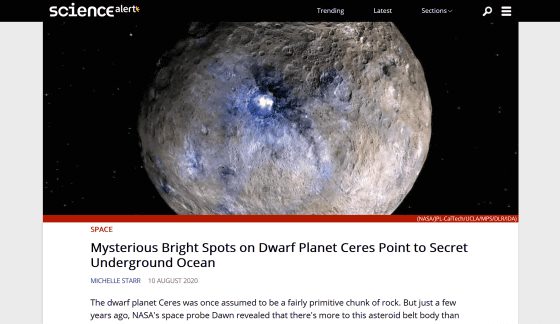It turned out that there is a possibility that the 'sea' has spread to the underground of the dwarf planet Ceres between Mars and Jupiter

by NASA
Located in the
Impact-driven mobilization of deep crustal brines on dwarf planet Ceres | Nature Astronomy
https://www.nature.com/articles/s41550-020-1168-2
Evidence of non-uniform crust of Ceres from Dawn's high-resolution gravity data | Nature Astronomy
https://www.nature.com/articles/s41550-020-1019-1
Recent cryovolcanic activity at Occator crater on Ceres | Nature Astronomy
https://www.nature.com/articles/s41550-020-1146-8
Fresh emplacement of hydrated sodium chloride on Ceres from ascending salty fluids | Nature Astronomy
https://www.nature.com/articles/s41550-020-1138-8
Mysterious Bright Spots on Dwarf Planet Ceres Point to Secret Underground Ocean
https://www.sciencealert.com/mysterious-bright-spots-on-dwarf-planet-ceres-point-to-secret-underground-ocean

Discovered in the early 19th century, Ceres is the only dwarf planet inside Neptune's orbit and the largest celestial body in the asteroid belt. In 2015, NASA launched an unmanned aerial vehicle '
While exploring Ceres, Dawn discovered that there was an extraordinarily shining 'light spot' inside the occluder crater that was thought to have been formed 20 million years ago. Initially it was thought to be one or two light spots, but later it became clear that more light spots were collected. And in 2016, researchers confirmed that the light spot of Ceres was formed of sodium carbonate .
The photo below shows the light spot in the Octocator Crater. Sodium carbonate, which forms the light spot, is often found around hydrothermal vents on the ocean floor on Earth. The ocean floor does not receive sunlight for photosynthesis, but near the hydrothermal vent there is a food chain of bacteria that uses chemical reactions to generate energy.

by NASA
Researchers have been wondering how the sodium carbonate found on the surface of Ceres was supplied. Perhaps the ice existing underground melted due to the heat of the meteorite collision and temporarily gathered as a liquid, or the temperature inside Ceres was higher than expected, and there was a liquid sea inside when the meteorite collided. Is an important concern. In the latter case, the question 'is the sea still present?'
In August 2020, research teams such as NASA and the Max Planck Institute published a series of new papers based on Dawn's data. This paper reports the results of analysis of high-resolution data taken mainly from the occluder crater, approaching Keres up to an altitude of 35 km after the Dawn's fuel was exhausted.
When the research team recorded gravity changes from the geological conditions around the crater from high-resolution data and combined it with thermal modeling, it was suggested that 'there is deep water below the crater.' In other words, it is highly likely that the sodium carbonate deposits found in the occluder crater were created by the eruption of the sea inside Ceres due to the heat and shock generated by the meteor impact.
The research team also points out that while the occluder crater seems to have been created 20 million years ago, the
Furthermore, when the light spot found in the occluder crater was analyzed by spectroscopy , the apex where the light spot became a dome was a rare mineral called Hydrohalite hydrated with sodium chloride. Turned out. Hydrohalite, which requires water, is very easy to dehydrate, so hydrohalite on the surface of Ceres cannot exist stably for a long time. According to the research team's calculations, it is possible that the liquid ejected from the inside just a few decades to a few hundred years ago formed hydrohalite on the surface of Ceres.

by Justin Cowart
Still, the mystery of how Ceres was formed and why it retains enough heat to allow liquids to remain inside is unknown. Ceres is becoming more and more serious, and it is expected that the 10-year plan for planetary science , which will start in 2023 , will also be investigated.
Related Posts:
in Science, Posted by log1h_ik







